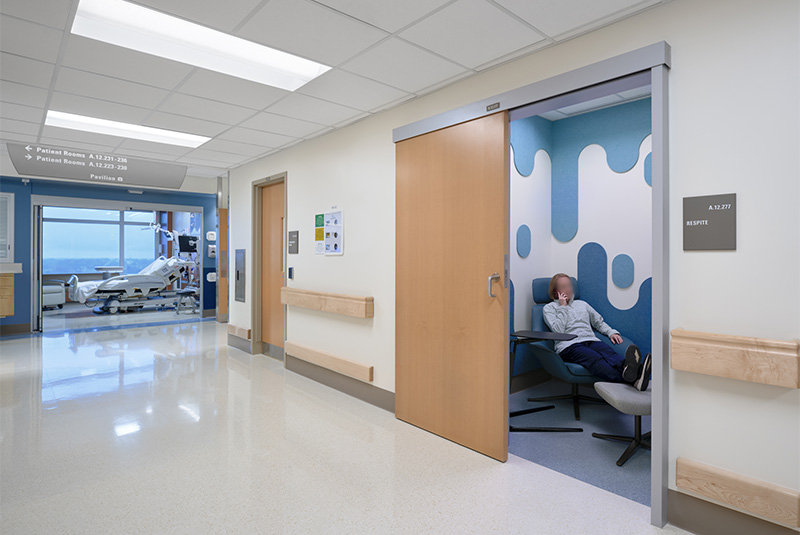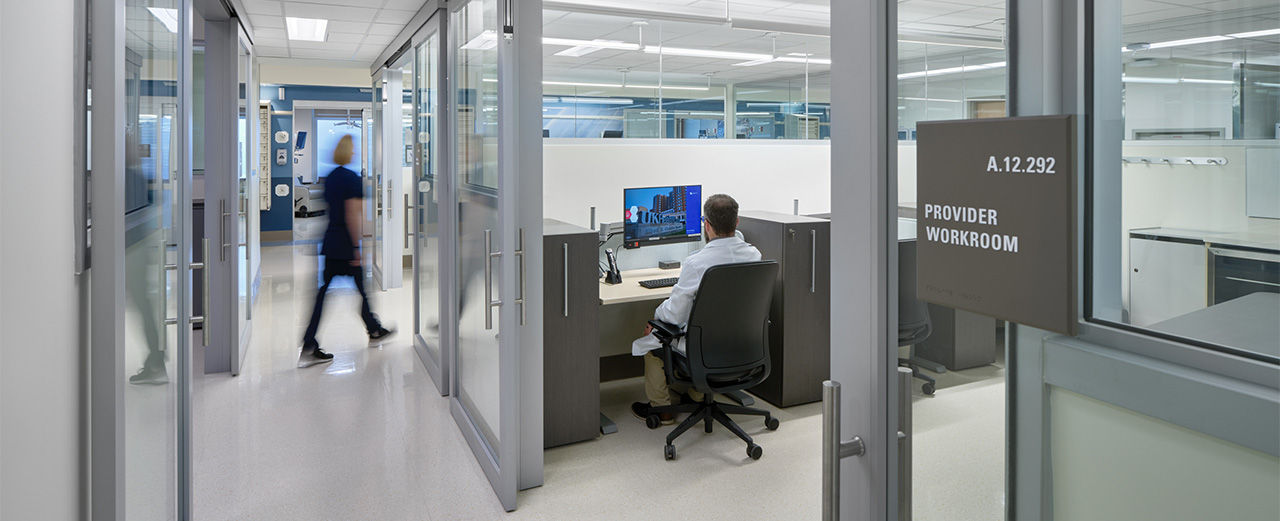
Commercial Sliding Doors Support Multiple Design Goals in Kentucky ICU
The medical and cardiovascular intensive care units (ICUs) inside the University of Kentucky’s Albert B. Chandler Hospital were once spread across multiple floors. However, at the beginning of 2024, these ICUs were consolidated into a single location—the 12th floor of the Pavilion A tower.
This rehoming simplifies access and maximizes the level of care the medical staff can provide. But the new ICU contributes more than just a single location. The 12th floor was also significantly updated from its original plans. These modifications were driven by patient and staff experience at various ICUs during the COVID-19 pandemic and other learnings from the 11 floors that preceded this one.
The resulting space provides state-of-the-art care, respite opportunities for medical professionals and a sense of well-being for all on the floor. To achieve all these goals and more required plans that prioritized space efficiency and design flexibility, especially in areas dedicated to heath care providers.
“With this project, we were aiming to learn from our clients latest pandemic experiences,” says Matt Nett, Associate from GBBN, the project’s architectural firm. “And we wanted to maximize programming opportunities and flexibility in this space.”
One way the GBBN team realized multiple design goals was through the use of commercial sliding doors in work rooms, consult rooms and nurse respite rooms. These systems helped save space and contributed to visual connection and acoustic isolation.
Achieving multiple design solutions in a single space
While many aspects of the original plans changed to adapt to occupant needs, flexibility remained a guiding principle. The designers at GBBN expanded the floor’s main corridors to provide space for mobile equipment. Stephanie Shroyer, Associate Principal and interior designer, explains, “We asked how can we make the equipment the staff uses every day moveable and changeable.”
“We also looked at where provider workstations were,” Shroyer continues. These rooms are designed to be interchangeable. As such, they allow individuals or teams from multiple subspecialities to use them for charting and other work. Because the sliding doors save space that would usually be taken up by swing arc trajectories, GBBN could make these work rooms larger without compromising other, adjacent design features.
Further, it was crucial to preserve visual connection in these rooms. Because they are decentralized and located at the ends of the floor’s perimeter corridors, solid doors and walls may have made the space feel isolated and less functional. GBBN used glass doors and windows to maintain as much visibility between spaces as possible. This allows nurses to feel more connected to their peers and patients. But creating a more visually connected ICU space was not the only consideration.
Limiting distractions to support the highest level of care
The work rooms and nurse respite rooms are located in areas where multiple activities take place. On the one hand, this supports collaboration between teams. On the other, it has the potential to create distractions when medical providers need to concentrate. AD Systems’ ExamSlide™ sliding door systems provide these spaces with Noise Isolation Class (NIC) ratings of up to 39, which supports acoustic isolation to limit distractions.
Shroyer explains, “Sound attenuation is an extremely important detail. Being able to close the doors and limit distractions is essential for an ICU.”
The premium acoustic performance of AD Systems’ sliding doors also supports other aspects of the floor’s design. Because these doors can significantly reduce sound transfer, they help the ICU achieve compliance with the Health Insurance Portability and Accountability Act (HIPAA) by limiting potential inappropriate disclosures of patient information to uninvolved individuals during peer-to-peer consultations.
Dr. Ashley Montgomery-Yates, Senior Vice Chair of Medicine at University of Kentucky, explains, “Creating a sound barrier to protect the healthcare providers as they communicated patient information was incredibly important for this project. But we also discovered that our staff and providers wanted the ICU space to feel more open and to have visible lines of slight to other spaces within the unit. These doors met both the visual and acoustic goals and have been a great addition to the unit.”
They also help maintain quiet across the floor to support occupant well-being.
“There are a lot of beeps and buzzes—the staff talked frequently about alarm fatigue,” Shroyer says. “Limiting sound transfer helps mitigate the noise that’s happening on the floor at any given time.” Sound attenuation is not just beneficial for workspaces; it also plays a key role in the nurse respite rooms.
Designing recharge spaces for medical staff well-being
The designers at GBBN planned two individual nurse respite rooms, four larger spaces for smaller groups of staff to rest and two additional shared consult and recharge rooms. These spaces are also fitted with AD Systems’ commercial sliding doors, which support efforts for space efficiency and sound attenuation.
Acoustically isolated recharge rooms help nurses decompress and rest during shifts. The immediate benefit is that this helps medical staff stay alert and focused throughout the day or night. In the long-term, this also supports efforts to reduce medical burnout, which remains a pervasive issue in medicine according to the American Medical Association (AMA).
“In both work and rest areas, these doors not only help maximize useable space, but they also create sound privacy,” Shroyer continues. “These doors can also lock, which supports the sense of privacy medical staff have while recharging.”
Dr. Montgomery-Yates elaborates, “For the solid wooden doors, the locking mechanism is necessary to provide a safe place for staff and providers to rest and reflect without concerns about someone opening the door and walking into the respite space. And for the glass doors, the workrooms needed to lock in order to provide limited access to the area where providers stored personal belongings and patient specific information.”
The ExamSlide doors were specified with card readers wired to magnetic locks to provide security and privacy to the floor. “With other sliding door systems,” Nett says, “it was a challenge to integrate these types of locks. The ability of AD Systems’ doors to facilitate locking made it easier to specify and made the space much more functional.”
Learning from the past, looking to the future
The 12th floor of this hospital represents the culmination of learning from the past and applying that knowledge to support the care provided both in the present and the future. By incorporating commercial sliding doors into select areas, the design team achieved several design goals within the tight space.
AD Systems’ sliding doors are space-efficient, maximize visual connection and limit sound transfer. These qualities optimize the space for flexibility and functionality to support both patients and providers. Likewise, ExamSlide’s durability and dependability also solved several challenges from previous floors.
“In the past, the project owners had issues with sliding doors in general within this facility,” Nett explains. “But AD Systems’ doors have held up to scrutiny from medical staff and have exceeded their expectations.”
Project location: Lexington, Kentucky
Architect: GBBN
General Contractor: Turner Construction
Hardware Contractor: Norwood Hardware
Sliding door system: ExamSlide, ExamSlide Bi-parting
Date completed: May 2023
Amount of Product: 25







